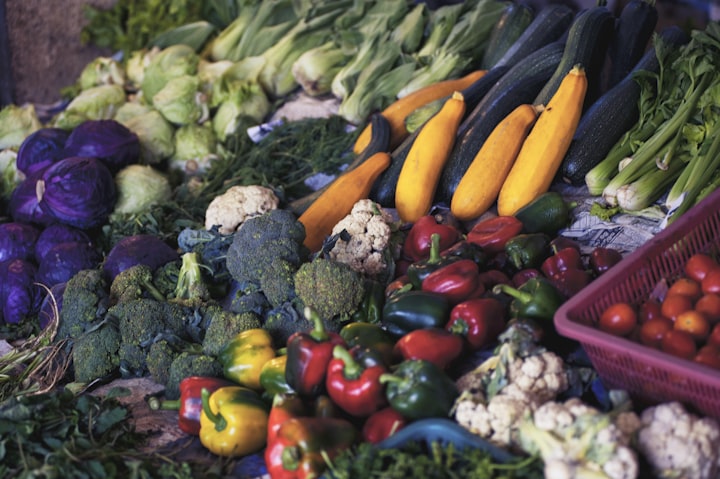
In order to give your body the nutrients it needs to function correctly, a balanced diet should contain a range of foods from all the major food categories in the ideal quantities. Here are some pointers for eating a diet that is balanced
Eat plenty of fruits and vegetables
To maintain a healthy and balanced diet, it's crucial to eat enough of fruits and vegetables. Fruits and vegetables are high in vitamins, minerals, fiber, and antioxidants, which can provide several health benefits. The following advice will help you increase the amount of fruits and vegetables in your diet
The fruits and vegetables you choose should be a diversity of colours since different hues contain different nutrients and antioxidants.
Fruits and vegetables can be added to meals in a variety of ways. You can swirl fresh berries into yoghurt or cereal, or you can add chopped veggies to omelets, soups, or stir-fries.
Fruits and vegetables make a healthy snack. Cut up vegetables like carrots, celery, and peppers for a snack, or grab an apple, banana, or other fruit for a quick and simple snack.
Create smoothies: For a nutritious and energising beverage, blend fruits and vegetables.
Fruits and vegetables can take the place of high-calorie snacks: For a healthy alternative to chips or candy, look for a piece of fruit or a handful of veggies.
To maintain a healthy and balanced diet, keep in mind that at least 5 servings of fruits and vegetables should be consumed daily.
Choose whole grains
In order to maintain a healthy and balanced diet, choosing whole grains is crucial. Whole grains are unrefined grains that include the bran, germ, and endosperm as well as all other sections of the grain. As a result, they serve as a good source of fiber, vitamins, and minerals. Here are some suggestions for increasing your consumption of whole grains
Select whole grain breads and cereals: Look for breads and cereals that show whole grains as the first component, such as whole wheat, oats, or brown rice.
Replace refined grains with whole grains: Opt for whole grain alternatives to refined grains such white rice, pasta, and bread.
Try out different whole grains: To add variety to your meals, try out different whole grains like quinoa, farro, or bulgur.
Create your own dishes with whole grains: Try creating your own meals with whole grains, like salads made with whole wheat pasta or brown rice.
To make sure you are purchasing a whole grain product, look for goods that are labelled "100% whole grain" or "100% whole wheat."
To maintain a healthy and balanced diet, keep in mind that at least half of your daily grain intake should be whole grains.
Include lean protein sources
Maintaining a healthy and balanced diet requires including lean protein sources in your diet. Lean protein sources can help you increase and maintain your muscle mass, control your appetite, and give your body vital minerals. Here are some pointers for increasing your intake of lean protein
Choose lean foods: Opt for lean meats, such as chicken, turkey, fish, and lean cuts of beef and pork, to lower your intake of saturated fats.
Eat plant-based proteins: Include plant-based protein sources in your diet, such as tofu, tempeh, beans, lentils, and chickpeas.
Protein-rich foods, such as nuts, seeds, or Greek yogurt, can be eaten as a snack to help you stay full and satisfied.
Replace high-fat proteins: To minimise your intake of unhealthy fats, swap high-fat protein sources such processed meats or fried chicken for lean protein sources.
Cooking protein in a healthy way involves using grilling, baking, or broiling rather than frying to cut down on extra fats and calories.
Remember that a healthy, balanced diet calls for 5 to 6 ounces of protein per day. To receive a range of important nutrients, aim for a variety of protein sources.
Limit saturated and trans fats
Saturated and trans fats can raise your risk of heart disease and other health issues, therefore limiting them is crucial for keeping a healthy and balanced diet. Following are some suggestions for cutting back on saturated and trans fats:
Choosing lean foods will help you consume fewer saturated fats. Some examples of lean meats include skinless chicken, turkey, fish, and lean cuts of beef and pork.
Using healthy fats in place of saturated fats: Substitute olive oil, canola oil, or other plant-based oils for butter, lard, or other animal-based fats.
Select dairy products with low or no fat content: To cut back on your consumption of saturated fats, select dairy products such milk, yogurt, and cheese that are low or no fat.
Limit fried meals: Trans fat levels can be high in fried foods like fried chicken and french fries. Try baking or grilling foods instead.
Check food labels to see how much saturated and trans fats are included in packaged foods, and then choose for lower-fat products.
Remember that for a healthy and balanced diet, it's advised to keep trans fats to a minimum and keep your daily intake of saturated fat to less than 10% of your total calories.
Limit added sugars
In order to maintain a healthy and balanced diet, it's crucial to limit additional sugars because too much sugar can cause weight gain, diabetes, and other health issues. Here are some recommendations for cutting less on added sugars:
Check food labels: Aim for packaged foods with fewer added sugars by looking for ingredients like high fructose corn syrup, cane sugar, or brown sugar in the ingredient list.
Fruit juice can be heavy in sugar and lacks the fibre present in whole fruits, but whole fruits have fibre that can aid reduce the absorption of sugar into your system.
Reduce your intake of sweetened beverages by replacing them with water, unsweetened tea or coffee, or low-sugar options like sparkling water or water with fruit infusions.
Use natural sweeteners: As an alternative to sugar, use natural sweeteners sparingly, such as honey, maple syrup, or stevia.
Limit your intake of processed and packaged foods because many of them include added sugars. Instead, aim to eat whole, unprocessed foods wherever feasible.
Keep in mind that for a healthy and balanced diet, the American Heart Association advises men to restrict their intake of added sugar to no more than 9 teaspoons (36 grammes) per day and women to no more than 6 teaspoons (24 grammes).
Choose low-fat dairy products
One approach to lower your intake of saturated fats, which can contribute to heart disease and other health issues, is to choose low-fat dairy products. The following advice can help you include low-fat dairy products in your diet:
Select fat-free or low-fat milk: The amount of calcium and other necessary nutrients in skim or low-fat milk is equal to that of whole milk, but there is less fat in it.
Choose low-fat cheese: To lower your intake of saturated fat, choose low-fat cheeses such mozzarella, feta, or cottage cheese.
Use low-fat yoghurt: In recipes, low-fat or fat-free yoghurt can be substituted for sour cream or mayonnaise to create a delightful, healthy snack or breakfast alternative.
Try non-dairy milk alternatives: These liquids are frequently lower in fat than regular dairy milk, making them a good choice if you're lactose intolerant or prefer non-dairy milk alternatives.
Always choose dairy products that aren't too processed and don't have additional sugars or artificial flavors, even though low-fat dairy products can be a healthy component of a balanced diet.
Stay hydrated
Water is necessary for numerous physical activities, including controlling body temperature, carrying nutrients, and eliminating waste, therefore being hydrated is crucial for keeping a healthy body. The following advice can help you keep hydrated:
Regardless of your body size, level of activity, and other considerations, you should drink plenty of water. As a general rule, you should aim to consume at least eight 8-ounce glasses per day.
Eat foods that are high in water content to stay hydrated. Examples of such foods include watermelon, cucumbers, and tomatoes.
Limit your intake of coffee and alcohol. Because these substances can dehydrate you, it's crucial to drink water or other hydrating liquids when you use them.
Carry a water bottle with you all day to remind yourself to drink fluids and to make it convenient for you to do so.
Drink water when you feel thirsty since thirst is your body's way of telling you that it needs to be hydrated.
Keep in mind that staying hydrated is crucial for your general health and wellbeing and can help you avoid dehydration, which can cause headaches, lethargy, and other health issues.
Always keep in mind that a balanced diet involves more than simply certain meals; it also involves your overall dietary pattern. To maintain a healthy and balanced diet, it's crucial to eat a variety of foods in moderation.






Comments
There are no comments for this story
Be the first to respond and start the conversation.